Porcelain Insulator News
by Jack H. Tod
Reprinted from "INSULATORS - Crown Jewels of the Wire", January 1977, page 24
The pricing for porcelain pin types has been completely revised in my Second
Edition. Too many collectors found the former system too complicated, so it was
entirely discarded. In its place is a lengthy list of all the better specific
porcelains with a price (or price range) for each one. You just look up any
insulator and read off the price directly,
The valuations are as realistic as we could make them. They aren't values
dreamed up by someone staring at the ceiling or throwing darts at a number chart
on the wall. I asked the following people to assist in the price determinations
- Lew Hohn, Rochester, New York
- Jerry Turner, Goshen, Ohio
- Dee Willett,
Bakersfield, Calif.
This group not only represents east-midwest-west, but it also resembles
collector-collector/dealer-dealer. Jerry is not a dealer but sets up a sell
table at more shows than any other porcelain collector and may buy, sell and
trade more porcelain insulators than anyone else in the country.
I and these three people independently arrived at a price for every item in
the entire list, and these values were then entered in summary lists. The final
price used was essentially the consensus median, after throwing out obvious
errors in value judgment and allowing for geographical differences.
I wish to publicly thank these people for the many hours they spent on this
pricing work. Hopefully through this tedious process we have a pricing table
which will be of maximum use to all collectors.
Jack
Dear Jack:
Noticed the bit about the NP-55 insulators in your column in CJ, so I thought
I'd add my comments. No doubt you will get a fair response from up here on
these.
NP stands for National Porcelain, which is a subsidiary of Medicine Hat Brick
& Tile Co., which is a subsidiary of I-T-E, which is etc. etc.
National Porcelain had an insulator plant in Medicine Hat, Alberta. I don't
know when they started manufacturing insulators, but it was many years ago.
Their plant burned down in 1972 or 1973, and they didn't rebuild. The insulator
part of the business was sold to a new company which is now manufacturing some
electrical porcelain but no pin types. They manufactured a number of pin types;
I have 9 styles (15 varieties) in my collection.
National Porcelain used an underglaze marking, recess-embossed marking and an
incuse marking (in that order I think). I also have a couple of older styles
that are marked on the petticoat rest with a small stamped N.P. which I think
(but don't know) are National Porcelain. Most are a plain chocolate brown, but
the old style turns up in white, and in the last few years of production they
were making sky glaze units.
I have always assumed that the 55 (in the marking) was the year of
manufacture, as the same style turns up with different numbers, and the same
numbers will be on different styles. As well, this ties in with the apparent age
of the various specimens.

These insulators are so common in Western Canada that their value is minimal.
Looks like you have been elected to be the clearinghouse for information on
Canadian porcelains as well, whether you want to be or not. There is a big gap
up here as far as porcelain info is concerned.

So, are you familiar with this one?? It's Sim U-302, nice white glaze,
marking on the crown as shown here. I don't know which way is up on this
marking. It's a new one on me.
Keith Ewart,
Moose Jaw, Sask., Canada
- - - - - - - - - -
Dear Keith:
We consider insulator collecting a joint U.S.-Canadian fad, and Crown Jewels
will always be available as a clearinghouse for U.S. and Canadian insulators
alike. Just look at all the many Canadian subscribers we have, and a great
number of you fellows are also porcelain buffs -- and the real eager variety at
that. Whenever we put a question to readers about Canadian insulators, you
fellows literally flood us with answers!
Your information about National Porcelain is great, and I'm sure one of our
readers up there will send us equally enlightening info an your mystery marking
shown above.
I've always wished someone in Canada would gather in this information about
Canadian porcelain companies and their insulators and publish it in book form.
Maybe you could all draw straws for the task. Until that happens, all of us down
here in the lover 48 are rather ignorant about Canadian porcelains.
Jack
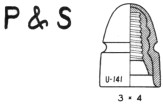
The U-141 shown at right was patented June 14, 1892 (#476,813) by Pass &
Seymour. It has a porcelain outer shell, an inner metallic thimble with
threads and an intermediate section of paraffin-filled cement. Collectors have
waited patiently for years to turn up one of these classics, but no success thus
far.
Reference page 23, May 1975 Crown Jewels, a transcript of the 1901 court
proceedings in a suit brought by Thomas re the Boch glaze-welding patent. In
relation to insulators made up of more than one component part, it states,
"There is no novelty in an insulator made up of separate parts fitted into
each other whether of the same or different material. This appears in the Varley
English patent, (1861,) the Johnson and Phillips, (1878,) the Pass and Seymour
Cuban insulator, (1892,) the Hauty, (1893,) the .... " (Emphasis mine, JT)
I have always been intrigued by the word "Cuban" in the above text
referring to the P & S insulator. They advertised that this superior design
resulted in the paraffin continually ablating to renew the insulating
properties, and I have seen references in other company documents about the
difficulty of maintaining good insulators in the Cuban environment.
After feeding these several facts into my crystal ball, it now tells me that
the next time one of you collectors gets skyjacked to Cuba, maybe you should
glance at the porcelain beehives on the poles down there before coming home.
Jack
Dear Jack:
I inadvertently found in a Thomas catalog the answer to my question about the
use of the MACOMB strain (ref page 34, November 1976 CJ). It's a break strain,
and they said "used universally with strap iron clevis to pole or cross
arm".
Gerald Brown,
Two Buttes, Colo.
Here is some information I've had for several years which I never felt was
important enough to collector interest to include in my reference books, but
maybe some of you O-B fans will find it of interest.
Ohio Brass Company's insulator manufacturing plant at Barberton, Ohio (Akron
High-Potential Porcelain Co. before O-B bought it in 1910) underwent a
succession of corporate name changes. The dates given below are ones I derived
from factory drawings at Mansfield and are only approximate, give or take a
year.
- Ohio Insulator Company (1910-1932)
- Ohio Brass Co., Ohio Insulator Co. Div.
(1932- 1936)
- Ohio Brass Co., Barberton Division (1937-current)
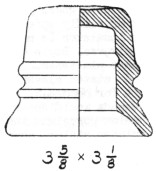
This insulator has been shown in the column three times previously, and most
recently December 1976. I received another letter from Douglas Henderson (Hawkesbury,
Ont., Canada), who owns this specimen, and he had additional information and
some theories why the insulator is probably not connected with the patent
#778,005 shown in December CJ. Without repeating all the detail, here are the
highlights.
Doug says the pinhole groove looks too shallow and irregular to be used with
a spring retainer and, more importantly, that the insulator design precedes by
many years the styles in use after 1900 and specifically the insulator used in
the patent drawings. The specimen was also used in the field, since it has
several small base and wire groove chips which are blackened with a layer of
grime such as found on insulators afield. Additionally Doug says,
"... I feel, and Jack Hayes agrees, that my insulator is a bonafide
threadless, and Jack has seen it. He told me that there is at least one other
insulator like mine and that it was shown on a TV program in Ottawa last January
(1976).
"I just had a phone call from Bill Bagg, Ottawa, Ont., and he told me
that he had seen and handled the insulator that was shown on the TV program.
Bill says that it is identical to mine, according to the description in the
article in Crown Jewels April '76, page 16, even to the shallow groove. It was
dug from an old dump in Cumberland, Ontario, which is about 55 miles upriver
from my place, and about 60 miles from Lachute, Quebec. The finder also found a M.
T. Co. threadless in the same dump...
"Bill states definitely that the second specimen is a real threadless,
and so mine must be. It is very interesting that they both were found within 60
miles of each other, one in a house and one in a dump.
"I learned that a man by the name of Farrar started a pottery in 1839 at
St. Johns, now St. Jean, Quebec. Conjecture Thus between 1840 and 1850 they could
have turned out pottery or porcelain insulators of the type in question. We may
trace it to its source yet. If it is truly of Canadian origin then to my mind it
is even more desirable....
"If you saw this insulator which is a very interesting specimen, I think
you would revise your theory.
"I regret that you feel that my insulator (U-975) is not a threadless
per se, and that because of its apparent Canadian origin you are going to remove
it from your chart of U.S. styles, but that is your privilege. However, may I
have the temerity to suggest that you reconsider your decision, in view of the
new evidence at your disposal-"
- - - - - - - - -
Well, I guess you've convinced me that this insulator is most certainly an
early threadless. I'm equally convinced this insulator is more likely than not a
Canadian item, and my Universal Style Chart is arbitrarily restricted to U.S.
unipart pin types. Thus, no-go on that count.
As stated elsewhere in this column, it would be a great event for both U.S.
and Canadian collectors alike if someone in Canada would spearhead the
publication of a book on Canadian porcelain insulators. There are so many
interesting insulator styles, company histories, etc. And the Canadian porcelain
collectors are real dynamos for digging out this information. I would be happy
to personally assist in the project in any way I could, except that I can't
envision spending several years touring Canadian porcelain factories and
libraries as I did in the U.S. for "our" insulators.
Jack

The U-186 is one of our favorite "patent top" insulators. The
patent involved is #1,107,111, August 11, 1914, Benjiman S. Purkey, Tacoma,
Washington. It has a "twist-lock" top for holding the conductor in
slack-wire fashion, as would be the case for tree insulators. Specimens have all
originated from west coast areas as far as I know, and we haven't yet been able
to find out which porcelain company made them.
From the specimens I've had and seen in other collections, I've always felt
that these were a glazeweld -- the entire crown portion glazewelded to the
bottom part. We just can't prove this until we find one with a defective glaze
job at the alleged joint, or unless we find one broken so badly that we could
relegate it to the lapidary saw, Dora told me several years ago she had a broken
one for this purpose, but after seeing it, I considered it still too nice a
specimen to chop apart for curiosity reasons, since these are a scarce style. We
need every collectible one we can find.
The first question for you readers is to ask if anyone does have a really
hopeless basket case of the U-186 we could saw apart to see if it's a glazeweld.
And also, can everyone of you look at your specimens in the alleged joint area
just under the crown to see if you can see a glazeweld joint.
The second question is this. Purkey had a second patent (#1,251,416, Dec. 25,
1917) on this same insulator except that it had gripping ridges in the top and
bottom surface of the slot termination, concentric with the axis of the
insulator. These were to bite into the conductor insulation and prevent it from
sliding through the slot -- namely, so it would not be a slack-wire insulator.
Has anyone ever seen a U-186 version like this??
Jack
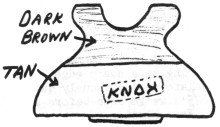
Dear Jack:
I need some info on two porcelain insulators I picked up. Due to the fact I'm
not knowledgeable on porcelain, I think I got took.... I had one of these
insulators on my table ... and I asked for an offer. She offered $1.00 and I
sold it. Now don't get me wrong. I was at fault for not knowing better, and I
did want to get rid of it. So, I am learning. Anyway at another table the same
insulator was being offered for $25. What do you think it was worth?
I am slowly learning that I must become a wheeler & dealer to get ahead
in this hobby. I don't want to -- I have lots of fun. I'd hate to spoil it.
Tom Wisser,
Linwood, N.J.
- - - - - - - - - -
Dear Tom:
You can relax. You were o.k. on it. This insulator is very modern and
possibly even current production. The older ones with plain brown glaze are
about $1 items, and may not sell at that. The more recent ones with the
contrasty glazes (radio treated tops) are just prettier and might fetch $2 to $3
on that count. As you said, you wanted to get rid of it, and you did that. If
you still have the second one, you might try for $3 or so on it.
Obviously you have a much better feel for the value of insulators than the
fellow at the other table with a $25 price on this same item.
The only way that makes one feel "took" is to first buy the one
with the $25 sticker on it and then see other tables like yours with $1 stickers
on the same thing. This is not to say one cannot occasionally find some bargains
on tables because the seller didn't recognize a goody when he had one.
Jack

Here's more info on the U-401 first reported in CJ, April 1975, page 23. That
specimen was marked I.E.P./1958, and I related the factory drawing on it at
Macomb was dated 1954.
Last year Chester Morris (El Paso, Texas) sent me a similar item, except that
it has a sanded hole with a 5/8" pin adaptor leaded and its porcelain part
is 3" tall instead of 3-3/4". It has an underglaze L-M marking.
I recently noted these were listed in the Joslyn catalogs starting with #15
(1945). and they were termed "Clamp Type Wireholders" and listed under
street lighting equipment. These had standard 1" pin hole. The 1945 cataloging means these could turn up with Illinois markings also.
Here are a couple of "goodies" I've seen recently.
Bob Reyburn (Ontario, Gal.) dropped by to show me some of his pet items and
make me drool. One was a U-670A Fred Locke (marking #1-9 on the skirt). This was
an off-white glaze typical of Locke items of the 1901 period, and it had a skirt
tapering to a sharp edge as the early Lockes have. This insulator was obviously
quite different from the Fred Locke U-675's we've seen before and which have a
longer petticoat.
Emma Almeida (Shrewsbury, Mass.) recently sent me a U-713 Imperial, white
glaze, markings #2 and #3 plus a manufacturing date of 9-20-99. I don't think
anyone has reported this style for Imperial before, but am not sure. In case you
Imperial fans don't have this one, you now have something new to chase after.
Emma has a couple of duplicates.
Also, recent word from Lew Hohn (Rochester, N.Y.): "... I seem to
remember a note awhile ago about Pittsburg H.V. lack of cobalt blue. I have Just
picked up 2 -- a cobalt blue U-267 and a cobalt blue U-12. Have the light blue
in each of these, and the cobalts are the same characteristics. Also have a true
gray in P.H.V. -- Sim U-358. I have a light blue in that also. A real
beauty!"
Dear Jack:
Enclosed is my check for a copy of your 2nd Edition.... It is so hard on some
of the shapes to exactly identify them with the drawings at quarter size. Is
there a method of enlarging the drawings to full size with the possibility of
pasting on cardboard, cutting out and using as a form to fit each insulator
into?
Errol Q. Bond, Sr.,
Fullerton, Cal.
- - - - - - - - - -
Dear Errol:
Cardboard templates are somewhat impractical for identification, since
porcelain pin types vary endlessly in exact size and shape, and it would be
endless work to make the templates. I have 5 large notebooks with prints of all
the U- drawings (they're drawn full size initially, then reduced), and I never
refer to these for identification of shape.
I really think you are overworking the exact identification. For instance,
most ordinary porcelain cables are 3-3/4", 4-3/4", 5-1/2",
6-1/2", 7-1/2" and 8-1/2" size, and the Style Chart has ample
shapes of each for you to pick out one that looks about like the specimen in
hand. Since all the U- drawings are 1/4-size in the book, I have always printed
a ruler on the back cover of my books so you can measure specimens to determine
their approximate size. They also print rulers on the covers of field guides for
bird identification, but I couldn't ever get the birds to come close enough or
stand still long enough so I could measure them like we can insulators.
Jack
Emma Almeida (Shrewsbury, Mass.) has one of the best collections of early
wiring insulators around, and here are three of her early ones showing design
evolution.
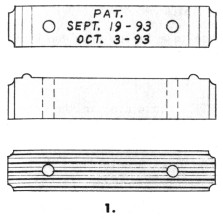
Cleat #1 at left is a nonreversible type (top and bottom halves different).
The base part has transverse grooves its entire length, and the mating part has
a plane surface. There are no conductor positioning slots.
Both patents are those of Buffinton & Dow. Sept 19 is #505,215 covering
the transverse gripping grooves. The Oct 3 patent is #505,912 for the spacer
ridges on the mounting surface.
Cleats #2 and #3 are of the reversible type (both halves being identical).
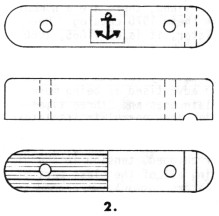
Cleat #2 with the anchor trademark (unattributed) is intermediate type with
the transverse grooves only half the length of the base, and is the first type
to have conductor positioning slots, one in each half.
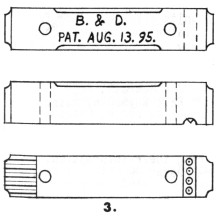
Cleat #3 shortens the transverse grooves still more but still has only the one
conductor positioning slot in each half. The Aug 13 B & D patent (#544,501)
is for the four small teats in the positioning slot to prevent the conductor
from sliding through the slot.
Note that Duggan (of Imperial Porcelain) held a prior patent (#508,687 of Nov
14, 1893) on a reversible cleat with corrugated slots on each end of both
halves. The B & D patent to use some other means for gripping the conductor.
| 